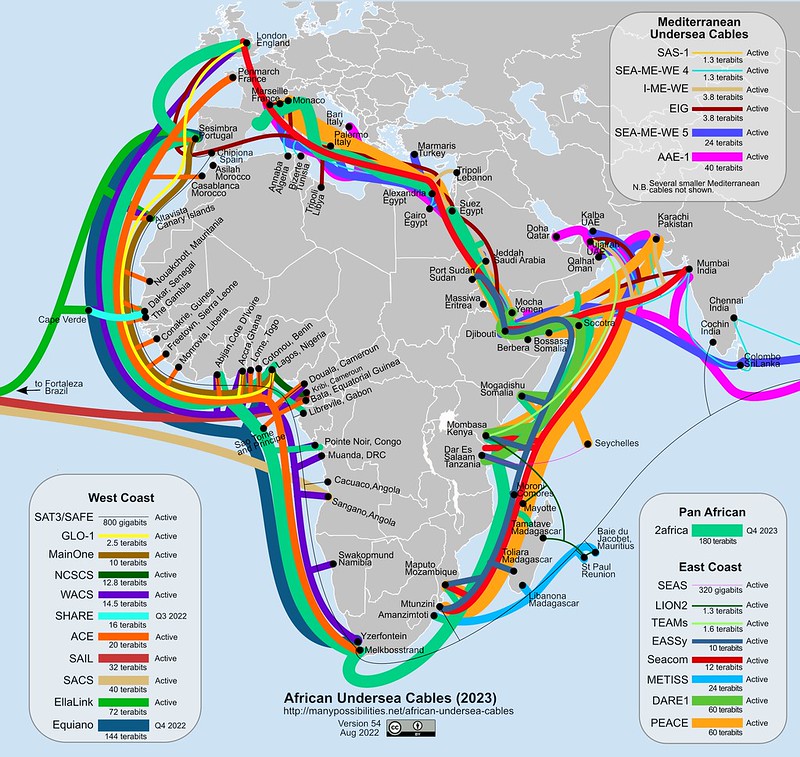Connectivity
Equiano cable promises
data and jobs boost
A partnership by Seacom with Google on the new subsea cable laid down on the West Coast of Africa will help meet the continent’s growing data needs, writes ARTHUR GOLDSTUCK.
The company that started the undersea cable revolution in sub-Saharan Africa, wholesale connectivity service provider Seacom, has partnered with Google on Equiano, the latest of more than a dozen subsea cables servicing the continent, which for South Africa could yield lower data costs, jobs and a boost to growth.
“A higher capacity of data coming into and out of the country will eventually impact data costs,” Seacom group chief digital officer. Prenesh Padayachee told us. “As competition increases in transmitting data into Africa, the cost of such data decreases, which will eventually benefit consumers and businesses.
“The Equiano subsea cable represents a new stage in Africa’s digital transformation, meeting Africa’s growing data requirements, enabling cross-border digital trade, and offering citizens and enterprises new opportunities.”
The Equiano cable stretches 15,000 kilometres from Portugal to South Africa, with landing stations in Melkbosstrand, Cape Town; Rupert’s Bay, St. Helena; Lomé, Togo; Lagos, Nigeria; and Swakopmund, Namibia. From these stations, branching units extend connectivity to other African countries.
Google anticipates the Equiano cable will have a major economic impact on these countries. A Regional Economic Impact Assessment commissioned by Google and conducted by Africa Practice forecast in 2021 forecast that the cable would increase South Africa’s GDP by $5.8bn and create 180,000 indirect jobs by 2025.
Subsea cables bring high-capacity Internet access to the countries where they connect, providing direct access to the global Internet, and reducing the time it takes for data to traverse the planet. It is experienced by the business user and consumer as seamless access to websites, apps, downloads and streaming services.
Google’s Equiano undersea cable, the largest yet to connect Africa to the global Internet, was completed late last year, and Seacom this week became its first local Internet service provider.
The Equiano cable offers express connectivity from Cape Town to Lisbon, “touching down” or branching off at various points along the West Coast of Africa, while still providing uninterrupted data transit. It joins 10 other cables on that coast, along with another eight on the East Coast – including the Seacom cable.
Until its arrival, the highest capacity cable serving the sub-continent was the West Africa Cable System (WACS), connecting South Africa with the UK. Owned by a consortium that includes MTN, Vodacom, Telkom and Liquid, WACS currently has a capacity of 14.5 Terabits per second (Tbps).
The Equiano cable, in contrast, has a 144 Tbps capacity, ten times that of WACS. However, this does not immediately mean higher broadband speed for the end-user, aince it does not affect users’ maxmim broadband speed directly. But it will have an impact on the efficiency of data transfers, which will be experienced as faster connections to the global Internet, as it elminates bottlenecks and slowdowns experienced as a result of inefficient connectivity and low capacity along the data route.
The biggest benefits will be in competition and cost.
“Seacom upgraded its core metro networks in Cape Town and Johannesburg, allowing for greater data throughput, which allows faster transfer of data, which translates into an improved user experience. The benefit to end customers is that the cable provides low latency bandwidth capacity, which translates to data and content being delivered at much higher speeds, near real-time.”
Seacom now offers private line services with latency speeds – the time it takes between a signal being transmitted and received – of around 110 milliseconds between South Africa and Europe, making it the fastest direct route between the continents.
It is a coup for Seacom, as the Equiano cable was primarily built to address Google’s own data requirements, says Padayachee.
“The cable further provides much-needed capacity between the continents and addresses the future needs of the growing demand for data.
“The major difference between what we have on this cable compared to other cable systems is that we have a direct route from South Africa to Europe and don’t drop off at any of the countries along the way. Advances in technology have facilitated running transmission services across such large distances, and this allows us to remain at the forefront of this technology curve.”
He says Google required Seacom to meet various equipment and installation requirements. It implemented these with the help of a technology partner, Infinera, which specialises in optical fibre networking. Undersea cables contain large numbers of “fibre pairs”, two separate optical fibres that transmit data in opposite direction.
“Seacom installed terminal equipment to activate capacity on a fibre pair on the cable system. Seacom extended the fibre pair from the cable landing station into our own environment in the Teraco data centre in South Africa, where we will be offering services on the cable.
“Due to the high capacity on the cable, we further upgraded our own regional terrestrial networks in Cape Town and Johannesburg to ensure the networks are at a standard capable of transmitting much higher volumes of data,” says Padayachee.
“This launch results from years of project negotiations and planning.”
- This feature first appeared in Business Times in the Sunday Times.













